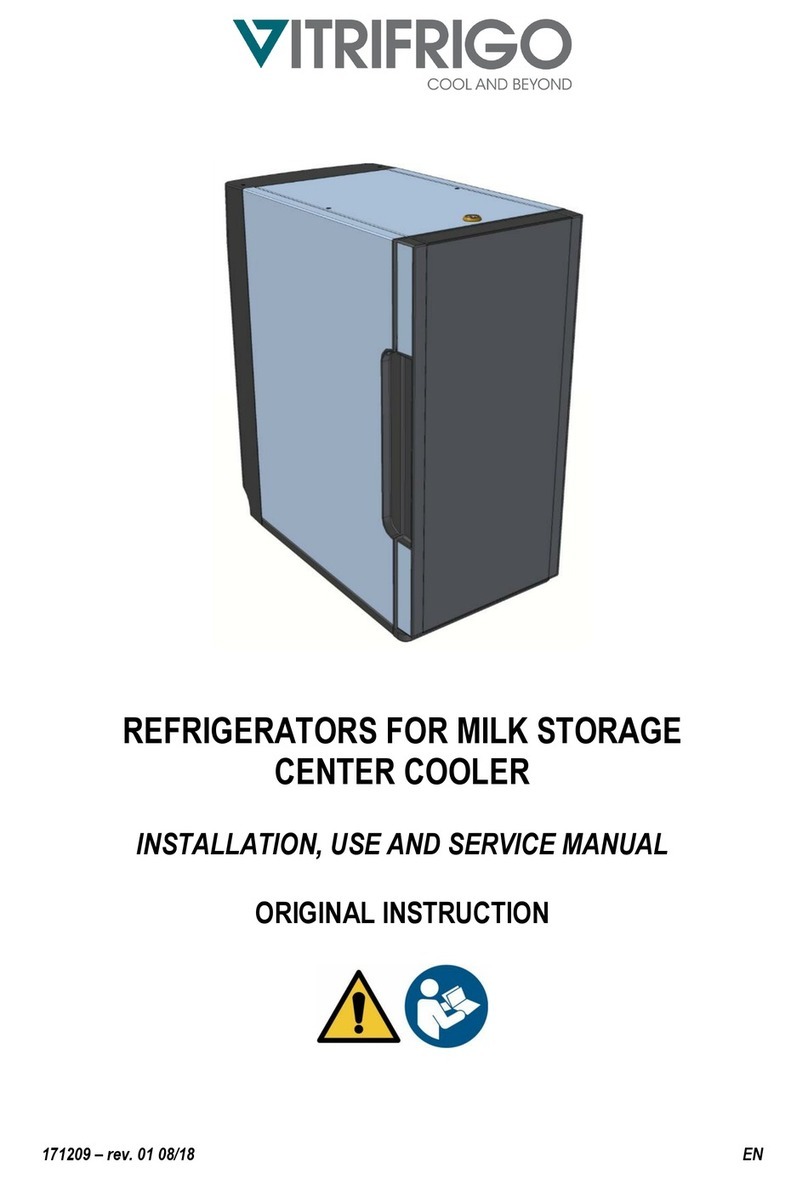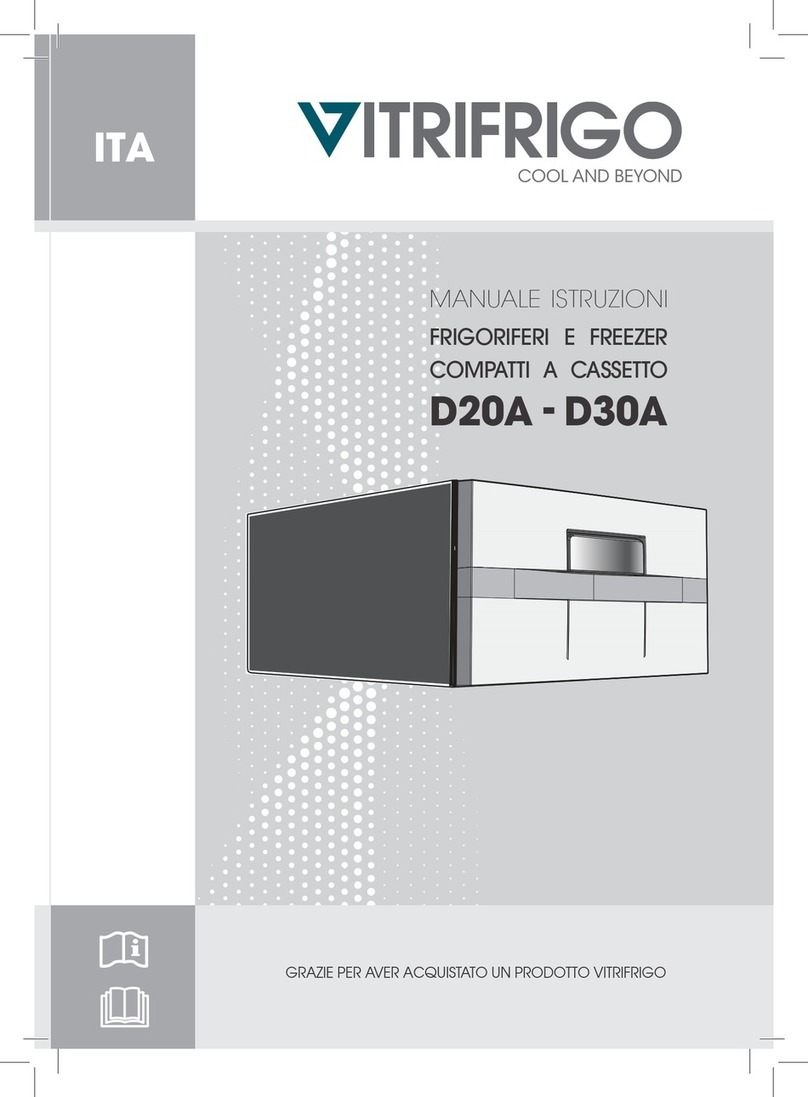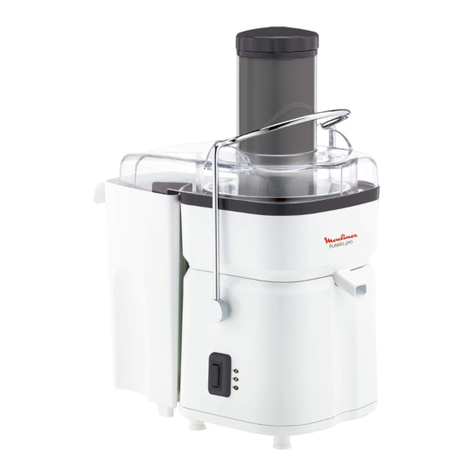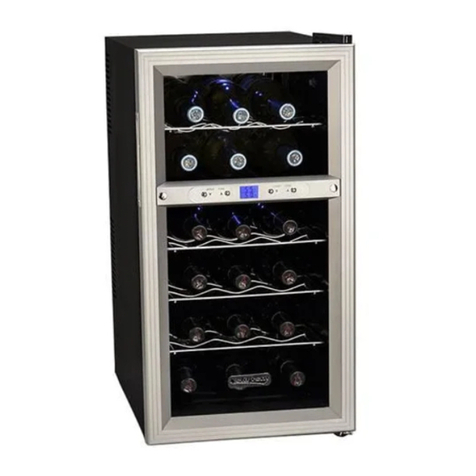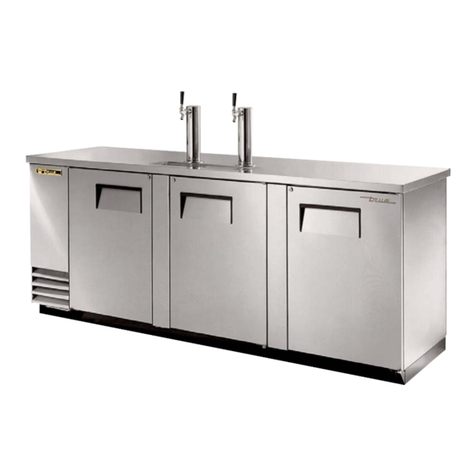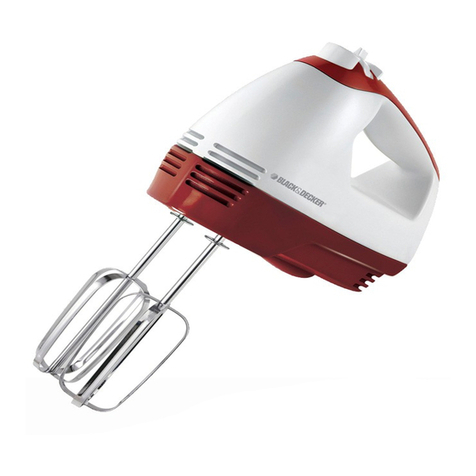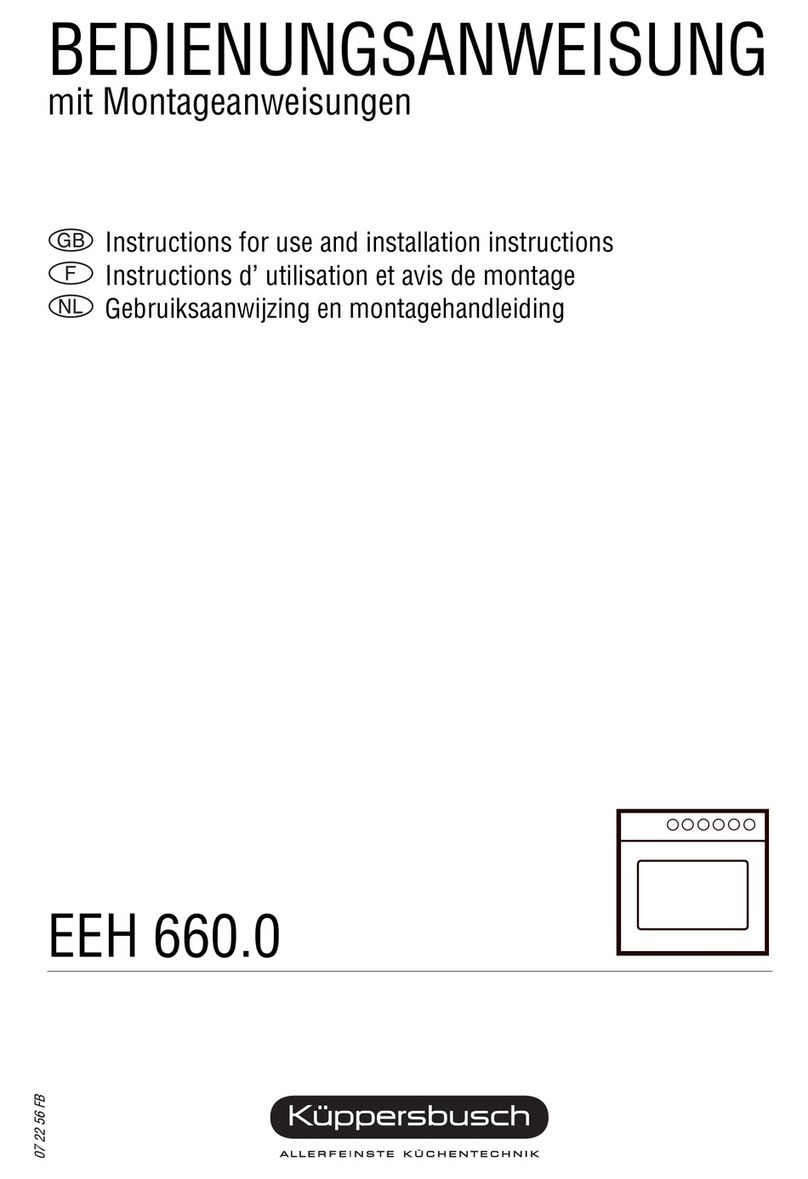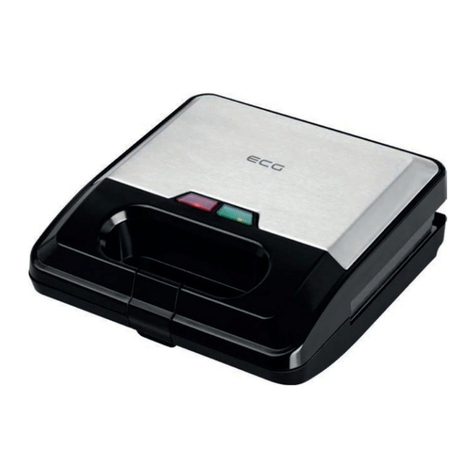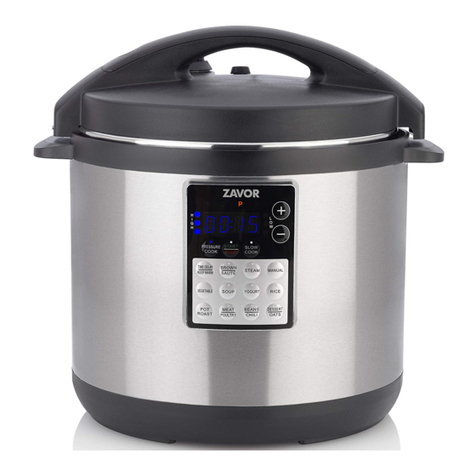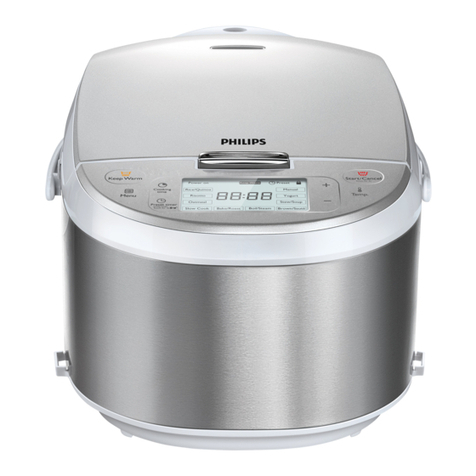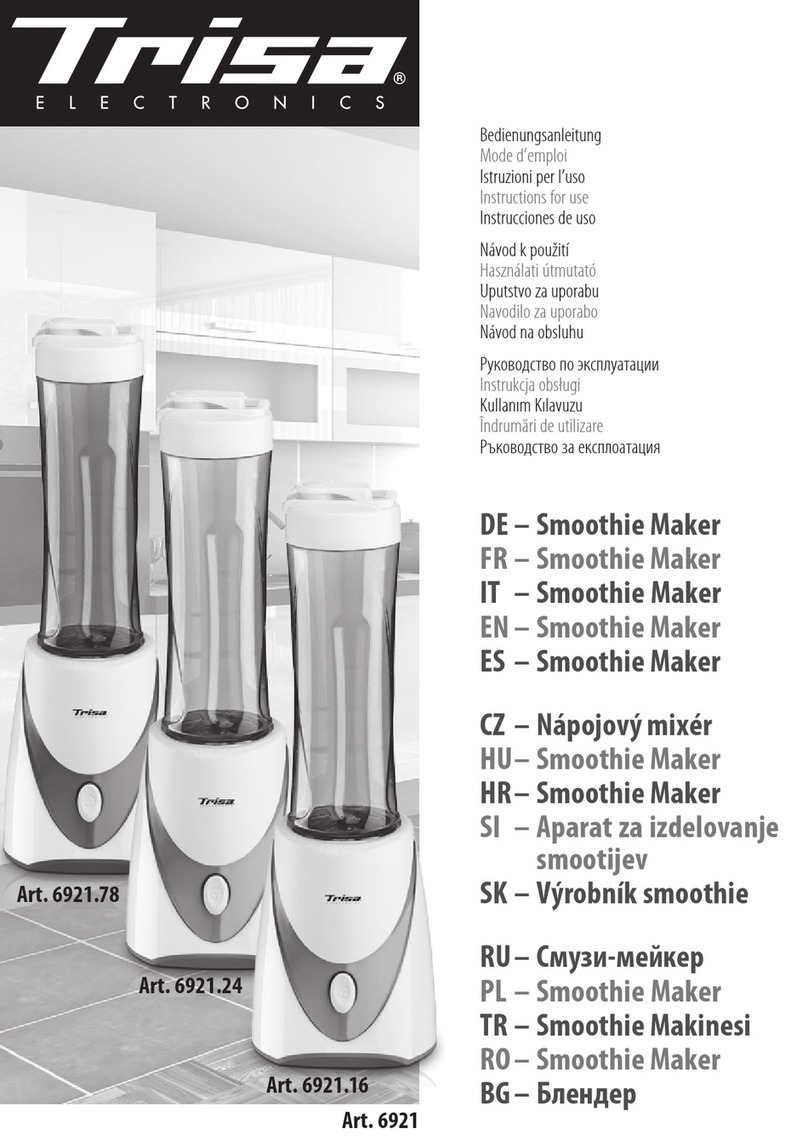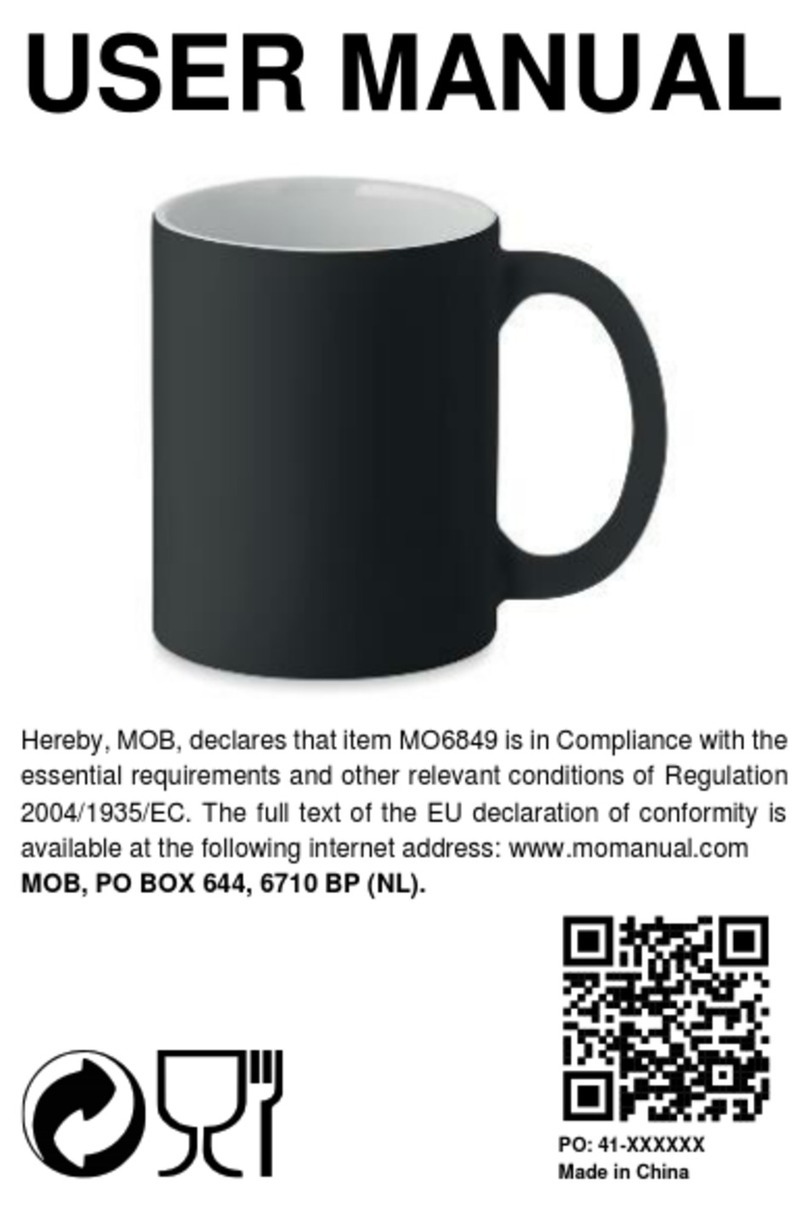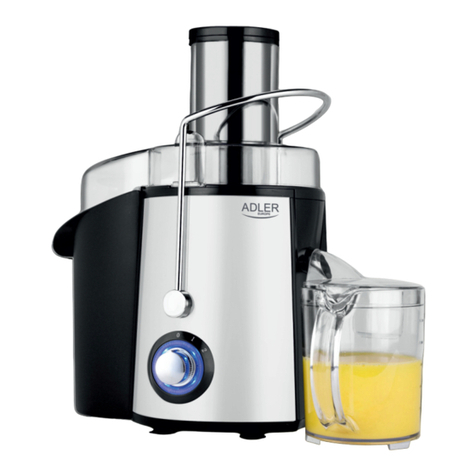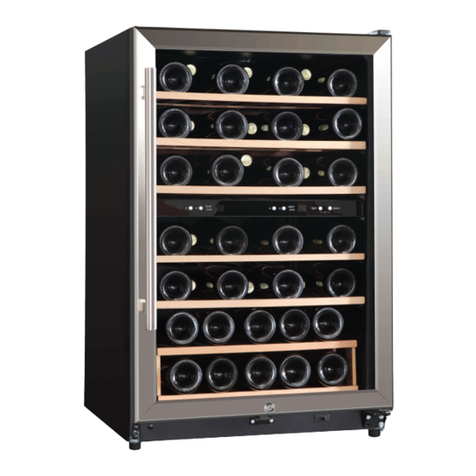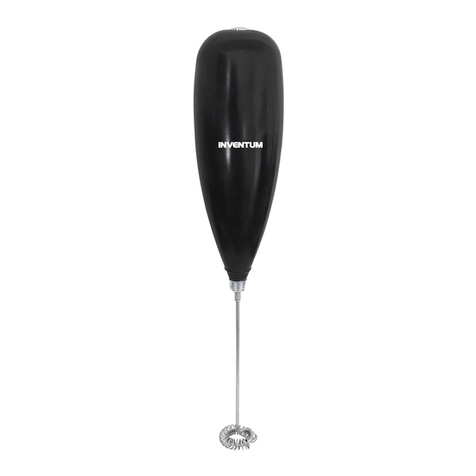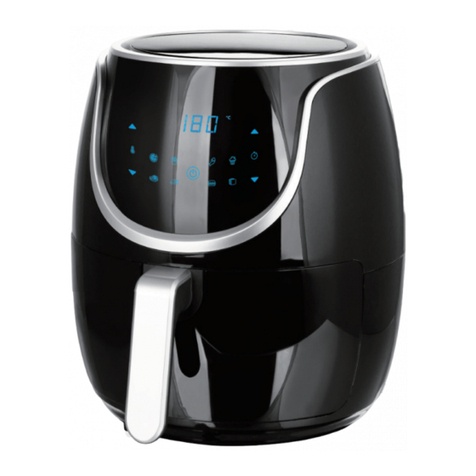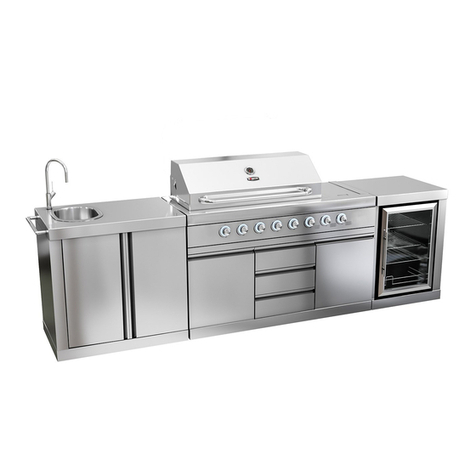Vitrifrigo FG10 Series User manual

171064.UNI – rev. 01 10/18 EN
REFRIGERATORS
FOR MILK STORAGE
INSTALLATION, USE AND SERVICE MANUAL
ORIGINAL INSTRUCTION

171064.UNI – rev. 01 10/18 EN

171064.UNI – rev. 01 10/18 EN
CONTENTS
1. Purpose of this manual
2. Safety warnings
3. Manufacturer identification
4. Product identification
5. General description
6. Description of operation
7. Installation and use
7.1 Checking the packaging
7.2 Positioning
7.3 Electrical connection
7.4 Use
7.5 Defrosting
7.6 Cleaning and maintenance
7.7 Non-ordinary maintenance and servicing
8. Disposal
9. Warranty claims
10. Troubleshooting

171064.UNI – rev. 01 10/18 EN
1 Purpose of this manual
This manual serves to provide instructions and useful
recommendations for the correct installation, start up, use,
maintenance and cleaning of the appliance as well as to point out
any residual risks or risks arising from incorrect use.
This manual must be considered an integral part of the appliance to
which it refers and as such, it needs to be kept with care.
As this manual refers to various refrigerators, its figures are to be
intended for information only. Some pictures may illustrate details or
parts that differ slightly from those on your appliance; this in no way
modifies essential information.
The manufacturer reserves the right to update this manual, when
considered necessary, at any time and without notice.
2 Safety warnings
The safe and correct use of this product requires you to follow the
rules and guidelines in this manual. The manufacturer cannot be held
liable for any damage arising from failure to abide by the warnings in
this manual.
The product referred to in this manual is made to store milk for
human consumption. No use other than that for which it was intended
is permitted. Any other use is considered improper and therefore,
hazardous.

171064.UNI – rev. 01 10/18 EN
Warnings and Important Safety Instructions in this manual do not
cover all possible conditions and situations that may occur. It is your
responsibility to use common sense, caution, and care when
installing, maintaining, and operating your appliance.
This appliance is intended to be used in household and similar
applications such as:
–staff kitchen areas in shops, offices and other working
environments;
–farm houses and by clients in hotels, motels and other
residential type environments;
–bed and breakfast type environments;
This appliance is not intended for use by persons (including children
aged less than 8 years) with reduced physical, sensory or mental
capabilities, or lack of experience and knowledge, unless they have
been given supervision or instruction concerning use of the appliance
by a person responsible for their safety.
Children should be supervised to ensure that they do not play with
the appliance.
Carefully read the labels on the refrigerator; do not cover them under
any circumstances and be sure to replace them immediately should
they become damaged.
R-600a or R-134a is used as a refrigerant. Check the rating label
inside the fridge to see which refrigerant is used for your refrigerator.

171064.UNI – rev. 01 10/18 EN
If in the refrigerator there is flammable gas (R600a refrigerant), you
will find this label on the compressor.
In this case, some special precautions must be taken:
-place the refrigerator in a well sized ambient.
-do not use the refrigerator if it seems to be damaged.
-In order to avoid damages on refrigeration circuit, do not use
mechanical devices or any other means to accelerate the
defrosting process.
-keep ventilation openings always free.
-if refrigerant leaks from the pipe, avoid any naked flames and
move anything flammable away from the product and ventilate
the room immediately.
-do not store explosive substances such as aerosol cans with a
flammable propellant in this appliance.
Do not place or use electrical appliance inside the refrigerator.
In case of malfunctioning disconnect power supply from the
refrigerator.
Servicing and maintenance operation on the refrigerator must be
ensure and performed by qualified service personnel only.
Some points of the internal condensing unit of the refrigerator may be
hot or have potentially sharp edges. Before carrying out non-routine
maintenance or servicing operation, disconnect the power supply and

171064.UNI – rev. 01 10/18 EN
wait for the time needed for the appliance to cool down. Always wear
suitable personal protective equipment, compliant with current
standards, when performing cleaning or maintenance.
Pay attention to the heated shelf (present in some models), since in
steady conditions, it reaches rather high temperature.
The “Electric Shock Hazard” label found on parts, casings and/or
covers serves to warn that their removal means being exposed to the
danger of coming into contact with energised parts.
Do not expose the refrigerator to jets of water and never use toxic
substances for cleaning.
Do not expose the refrigerator to sources of heat.
In case of fire, use extinguisher powder.
The packaging material must be disposed in compliance with current
regulations.

171064.UNI – rev. 01 10/18 EN
3 Manufacturer identification
The product referred to in this manual is designed and made by
Vitrifrigo s.r.l
Via Giuseppe Mazzini 75 – Frazione Montecchio
61022 VALLEFOGLIA(PU) - Italia,
Tel. +39 0721 154500
Fax + 39 0721 497739
4 Product identification
Each refrigerator has an identification label containing the following
information:
- model
- unit identification code and serial number
- refrigerated compartment volume
(or milk container volume)
- climatic class
N: functioning from 16°C up to 32 °C ambient temperature
4: functioning up to 30 °C ambient temperature and 55% rH
T: functioning from 16°C up to 43 °C ambient temperature
5: functioning up to 40 °C ambient temperature and 40% rH
- compressor model
- power supply voltage and power frequency
- total current consumption of the refrigerator
- current consumption of the heaters (if present)
- IPX3 protection grade (only for products with heated shelves)
- refrigerant type and quantity
- expanding gas for the insulation foam
- LP/HP pressures (only for USA products)

171064.UNI – rev. 01 10/18 EN
5 General description
The product referred to in this manual is expressly designed to be
coupled with coffee machines for guaranteeing the correct storage of
milk at a controlled temperature.
NOTE: refrigerator has not been designed to cool down the milk from
the ambient temperature (or above).
Some models also have cup warmer shelves, for the hot maintaining
of the cups and/or glasses.
The max weight of the device (with its milk container and empty cup
warmer shelves) is 20 kg.
The A-weighted emission sound pressure level of the appliance is
below 70 dB(A).
6 Description of operation
The refrigerator operates using a refrigerant vapour compression
cycle that transfers heat from the inside to the outside, making it
possible to keep the liquid for human consumption stored inside it at
a constant, pre-set temperature.
The refrigerant evaporates by removing the heat from the air via the
cold inside walls of the refrigerator (in contact with the evaporator
through which it flows) before entering the compressor. Here the
pressure and temperature of the refrigerant are increased and it is
then passed through an air-cooled condenser, where it is condensed.
Lastly, the refrigerant fluid returns inside the evaporator via capillary
and the cycle is repeated.

171064.UNI – rev. 01 10/18 EN
The internal temperature can be modified using the (mechanical or
electronic) thermostat.
In some models there are shelves - typically made of stainless steel -
heated by heating elements inserted inside them. The temperature of
the shelves is generally fixed, and for each shelf there is a safety
thermostat, which shut off the heating element in case of
overheating.
7 Installation and use
7.1 Checking the packaging
As soon as the package arrives, inspect it, making sure that it is not
upturned and that it has suffered no damage during transport.
Remove the packaging and inspect the unit for damage of any kind.
If there is any doubt as to the integrity of the system parts, do not use
the refrigerator.
You must inform your dealer of any damage and/or anomalies not
later than 24 hours from the delivery date.

171064.UNI – rev. 01 10/18 EN
7.2 Positioning
Place the refrigerator on a horizontal surface and use the adjustable
feet to level it, if needed.
When positioning moving the refrigerator, be careful not to roll over
or damage the power cord.
When choosing the position of the refrigerator, remember that a gap
of at least 50 mm (2 in.) is required between the back panel of the
refrigerator and any wall in order to allow the warm air from
condensation to escape.
The same gap of at least 50 mm (2 in.) is required between the top of
the refrigerator and any wall above it.
As far as any space requirements at the sides of the refrigerator are
concerned, there are no specific instructions.

171064.UNI – rev. 01 10/18 EN
7.3 Electrical connection
The refrigerator is equipped with a IEC connection socket and a main
power switch, generally on the back panel.
The power cord suitable for the country in which the refrigerator will
be used is supplied with the product.
NOTE: In some models, the power cord comes out directly from the
inside of the refrigerator
Before connecting the refrigerator to the main electrical line, make
sure that the supply has the same characteristics (voltage, number of
phases, network frequency and amperage) as those stated on the
product label.
Grounding the appliance is mandatory, therefore you must ensure
that the electrical system to which the refrigerator will be connected
is grounded.
The manufacturer declines all liability for any damage suffered by
people or property as a result of failure to abide by the above
instructions.
To connect the refrigerator to the main electrical line, insert the plug
into a socket without using adaptors, multiple sockets and/or
extension cords.
Do not locate multiple portable socket-outlets or portable power
supplies at the rear of the appliance.

171064.UNI – rev. 01 10/18 EN
7.4 Use
The refrigerator has one (or more) hole for ducting the pipe to pick up
milk from the container placed inside.
NOTE: apply the dedicate transparent cap on the not used holes.
The refrigerator must be used only with the provided tank, in any
case with closed milk containers.
NOTE: the milk container can be filled with milk up to its max
capacity.
NOTE: the max weight admitted into the refrigerated compartment is
equal to the weight of the milk container (full of milk)
7.4.1 Setting (mechanical thermostat)
Some models are equipped with a mechanical thermostat, generally
placed on the back panel.
In the OFF position, the refrigerator is switched off.
Moving the thermostat to MIN, will start the refrigerator.
Adjusting the thermostat towards the MAX you can
modify – indirectly – the internal temperature.
The optimum temperature adjustment range for the application for
which the refrigerator is designed, is between the MIN and MAX
settings marked on the thermostat.

171064.UNI – rev. 01 10/18 EN
As the thermostat is moved closer to the MAX position, the
temperature inside the refrigerator will become lower.
NOTE: The refrigerator can operate at lower temperatures than the
level obtained by setting the thermostat to MAX by turning the dial
clockwise past this setting and as far as it will go. However, since
these temperatures are out of the range for storing milk, the
manufacturer advises against using the refrigerator in this way.
Once switched on, the refrigerator will begin to operate, but a certain
amount of time is needed (depending on external conditions as well
as on the thermostat setting) for it to reach the required internal
temperature.
We recommend to inserting milk inside the refrigerator only once the
internal temperature has stabilized.
7.4.2 Setting (electronic thermostat)
In the refrigerator equipped with electronic thermostat, it is generally
placed on the frontal panel.

171064.UNI – rev. 01 10/18 EN
ON/OFF switching
When the refrigerator is switched on, but in standby mode, the
thermostat’s display shows alternatively OFF and the inside
temperature value.
To turn on the refrigerator, hold the button pushed for at least 3
seconds. You will see ON on the display and immediately after the
inside temperature value. Holding again the same button will switch
the refrigerator off.
NOTE: together with the refrigerator, also the cup warming shelf (if
present) will be turned ON
Once turned on, the fridge will start working, but it will take some time
(also depending on external conditions and temperature setting) to
reach the required internal temperature.
We recommend to store milk inside the refrigerator only when the
internal temperature has stabilized to the required value.
Temperature setting
To set the desired temperature, push the button until you see the
current set point value flashing, then adjust the value using the
button (to increase) and (to decrease); to store the new
value press again the button .
NOTE: To ensure that the milk is always maintained at temperature
allowed by the HACCP, the setpoint can be varied only within a
specific values range.

171064.UNI – rev. 01 10/18 EN
7.4.3 Heated shelf for cup warming (if present)
Cup warming shelf is connected to a dedicated ON/OFF switch or to
the electronic thermostat of the refrigerator.
In the first case, push the ON/OFF switch to activate/deactivate the
heaters.
In the second case, hold the button for 1 second.
When the cup warmer module is turned on, “AUX” text is displayed
on the thermostat.
The shelf will begin heating, and it will reach its steady-state
temperature after 10 minutes.
Then, you can place mugs and/or cups, paying attention to the high
temperature of the shelf.

171064.UNI – rev. 01 10/18 EN
7.4.4 Milk level sensor functioning (if present)
The level sensor detects the presence of milk in the container and
generates an alarm when the level falls below a certain level
(generally between 0.5 l and 1 l) of milk.
If the sensor is connected to the digital thermostat, the alarm is
displayed by a flashing "AS" sign and by a buzzer too.
In some products, the sensor signal comes out from the refrigerator
(through a connector) and is connected directly to the coffee
machine.
7.5 Defrosting
If the refrigerator is left to operate for very long periods of time, it is
possible for ice to form on its inside walls.
If the ice becomes considerably thick, it is advisable to defrost the
refrigerator, to continue to guarantee good appliance efficiency and
avoid higher electricity consumption.
To defrost the appliance, switch it off; we recommend to leave the
refrigerator door open to speed up this operation.
Never use tools or any type of utensils to remove ice, this could
damage the evaporator, which is in contact with the inside walls of
the refrigerator. The manufacturer cannot accept any liability for
damage to the appliance caused by failure to abide by this
recommendation.
NOTE: During defrosting operation, do not leave the milk container
inside the refrigerator.
At the end of the defrosting operation, after cleaning and thoroughly
drying the inside walls of the refrigerator, switch it on.

171064.UNI – rev. 01 10/18 EN
7.6 Cleaning and maintenance
Under the current regulations regarding health and safety, the
operator is responsible for the hygiene of food contact materials and
must maintain and clean the unit, preventing the bacteria formation.
Before performing any cleaning and / or maintenance operation,
disconnect the electrical supply to the refrigerator.
This important information is written on a plate placed on the back of
the product.
The outside of the refrigerator (plastic coated steel) can be washed
first with warm water and then rinsed in cold water and dried with a
soft cloth. Do not use abrasive products.
To clean the inside of the refrigerator, after removing any containers
of milk or similar liquids for human consumption, wipe with warm
water and if necessary, a little vinegar to remove any grease. Rinse
with clean water and dry with a soft cloth. Never use abrasive
products, detergents or soap.
It is also advisable to make sure that the air-cooled condenser of the
refrigerating unit at the back of the appliance is clean. If it is
particularly clogged with dust, this should be removed using a
vacuum cleaner.
In case of a prolonged period of disuse, we advise you to disconnect
the refrigerator from the power supply, empty it completely, clean it
and leave the door slightly open to prevent the formation of mold
and/or unpleasant smells.

171064.UNI – rev. 01 10/18 EN
7.7 Non-ordinary maintenance and service operation
Servicing and maintenance operation on the refrigerator must be
ensure and performed by qualified service personnel only.
Access to the service area is permitted only for persons with
knowledge and practical experience with the unit, especially
regarding safety and hygiene. They need be equipped with the right
personal safety devices.
The refrigerator must be set up such that care and maintenance are
not hindered.
8 Disposal
If the refrigerator needs to be placed out of service, it must not be
disposed of as household waste but taken to a refuse recycling
centre. This is shown by the
symbol on the product label.
Use specialist waste collection centres that are certified according to
current standards.
If not correctly disposed of, the product can be harmful to the
environment due to the specific substances it contains. The
refrigerant inside the system must not be disposed of with normal
waste.
Incorrect disposal or illegal dumping of the product will lead to severe
legal penalties of an administrative and/or criminal nature, as
envisaged by current laws.

171064.UNI – rev. 01 10/18 EN
9 Warranty claims
The warranty period starts from the date of delivery to the final user.
The vendor should always be afforded the opportunity to rectify
errors within an appropriate period.
Claims that exceed the above terms, in particular damage claims as
a result of consequential damage, are excluded to the extent that this
is legally permissible.
Material defects shall be reported to the vendor immediately and in
writing.
No warranty is provided:
-on any parts subject to natural wear and tear. These include the
milk container, the parts carrying milk and the front door’s seal.
-for malfunctions due to the effect of the weather, chemical,
electrochemical or electrical effects.
-if malfunctions occur as a result of failure to follow handling
instructions and regulations, maintenance and care of the unit.
-if malfunctions occur as the result of use non original replacement
parts or incorrect assembly by the purchaser or by third parties or
by faulty or negligent treatment.
-if improper modifications are made without our consent or in case
of repair or reconditioning work on the part of the purchaser or by
third parties.
-in respect of faults caused by inappropriate or improper use.
Table of contents
Other Vitrifrigo Kitchen Appliance manuals
